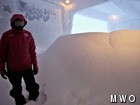Dealing with a big drift
2010-03-15 22:46:56.000 – Brian Clark, Observer and Meteorologist
Here is my very scientific meteorological evaluation of the weather pattern on Mount Washington for the last several weeks:
Sunny, sunny, sunny, STORM, sunny, sunny, sunny, STORM
The ‘storm’ part of that pattern has fallen on my shift for a while now. In fact, the latest storm just began to move out of the region this morning. Starting early Sunday morning and ending late this morning, we received over 17 inches of snow, all on moderate to strong east winds. Now last shift I wrote a lot about how uncommon east winds are on the summit and how difficult they can be to deal with. Unfortunately my shift has seen more east winds than any other direction lately. Just like the storm two weeks ago, we have had some pretty incredible drifting on the summit, especially in front of the main entrance to the Sherman Adams State Park building.
Here are some pictures from today:
A very interestingly shaped drift
The full size of the drift, right before shoveling
A layered pic, showing before and after (thanks to Ryan for this great photo)
You can check out more pictures from today on the Observatory’s page on Facebook. Also, head on over to our YouTube site to check out two really neat videos from today: one of the drift forming, and one of us shoveling it!
Brian Clark, Observer and Meteorologist
Team Flags Return for Seek the Peak’s 25th Anniversary
Team Flags Return for Seek the Peak's 25th Anniversary By MWOBS Staff Mount Washington Observatory is looking forward to continuing a much-loved tradition for Seek the Peak’s 25th Anniversary: Team flags. In inviting teams
Meet Summer Interns Zakiya, Max and Maddie
Meet Summer Interns Zakiya, Max and Maddie By MWOBS Staff We are excited to welcome six teammates to the summit of Mount Washington this summer! During their internship, these students and graduates will play
Saying Goodbye to the Summit
Saying Goodbye to the Summit By Alexis George After an extraordinary last three years working as a Weather Observer and Meteorologist, I am excited to pursue a different career. As sad I as am






